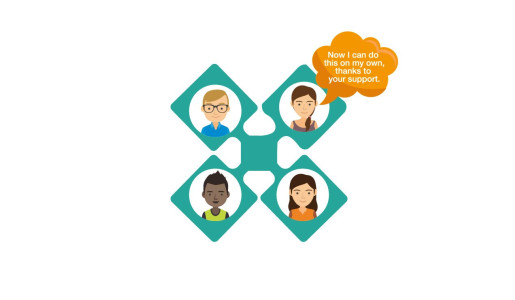Wraparound is a team-based planning process intended to provide individualized, coordinated, and family-driven care to meet the complex needs of the following children:
- Those involved with various child- and family-serving systems (e.g., mental health, child welfare, juvenile justice and special education).
- At risk of out-of-home placements, such as residential treatment centers or foster care.
- Those who have experienced emotional, behavioral and/or mental health difficulties.
How Wraparound Works
Develop The Plan
Families, providers, and key members of the family’s social support network collaborate to build a creative plan (referred to as a Plan of Care or POC) that responds to the particular needs of the child and family.
Implement The Plan
Team members then implement the plan and continue to meet regularly to monitor progress and make adjustments to the plan as necessary.
Complete The Plan
The team continues its work until members reach a consensus that a formal wraparound process is no longer needed.
We have consistently demonstrated that positive outcomes can be achieved despite significant trauma, mental illness, and psychosocial stressors through this strength and team based approach.
Principles
The Wraparound process works with families in customizing a treatment plan utilizing a wide array of community resources and services through a provider network of both individualized providers and agencies. The treatment team, including family, providers and natural supports, adhere to the following principles of the Wraparound philosophy.
Family and child perspectives are intentionally elicited and prioritized during all phases of the Wraparound process. The team strives to provide options and choices such that the plan reflects family values and preferences.
The Wraparound team consists of individuals agreed upon by the family, committed to them through informal, formal, and community support and service relationships.
The team actively seeks out and encourages the full participation of team members drawn from family members’ networks of interpersonal and community relationships. The Wraparound plan reflects activities and interventions that draw on sources of natural support.
Team members work cooperatively and share responsibility for developing, implementing, monitoring and evaluating a single Wraparound plan. The plan reflects a blending of team members’ perspectives, mandates and resources. The plan guides and coordinates each team member’s work toward meeting the team’s goal.
The Wraparound team implements service and support strategies that take place in the most inclusive, most responsive, most accessible and least restrictive settings possible; and that safely promote child and family integration into home and community life.
The Wraparound process demonstrates respect for and builds on the values, preferences, beliefs, culture, and identity of the child, family, and their community.
To achieve the goals laid out in the Wraparound plan, the team develops and implements a customized set of strategies, supports and services.
The Wraparound process and the Wraparound plan identify, build on, and enhance the capabilities, knowledge, skills, and assets of the child and family, their community, and other team members.
Despite challenges, the team persists in working toward the goals included in the Wraparound plan until the team reaches agreement that formal Wraparound services are no longer required.
The team ties the goals and strategies of the Wraparound plan to observable or measurable indicators of success, monitors progress in terms of these indicators, and revises the plan accordingly.
Featured FAQs
-
QHow many different team members, on average, are part of a Wraparound team?
Every wraparound team is individualized to meet the needs of the individual or family based on their needs. Teams will range in size and can include family, natural supports and service providers.
-
QCan I decide who is on the Wraparound team for myself or my family?
A principle of wraparound is Family Voice and Choice, meaning that the treatment planning, including team members, is determined and led by the family.
-
QWho is the leader on a Wraparound team?
The client has complete control over their treatment and should lead their team in navigating their care, however there will always be an ICAN staff supporting every step of the way.
-
QWhat if someone in my family, or I, do not connect with one or more of the specialists on my Wraparound team?
Every individual has the power to choose the care they participate in, so any issues with team members can and should be addressed with the team during meetings.

